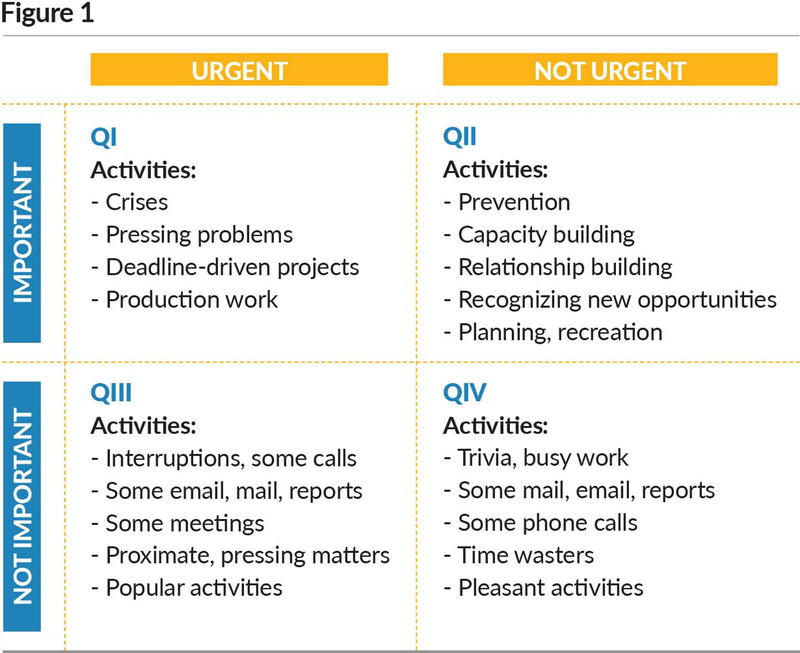
Over the past four issues, we have reviewed major factors that contribute to creating a culture for higher performance. We concluded last month with a focus on the necessary work of leadership. In this article, we look at the concept of a parallel organization—a way to perform the work of leadership alongside our production work.1
Choosing Our Work, Using Our Time
In his book, Seven Habits of Highly Effective People, Stephen R. Covey adapted a time management system used by then General, later President Dwight Eisenhower to demonstrate how most of us sort and decide what we choose to do each day. In Covey’s time matrix, shown in Figure 1, the vertical axis represents the degree of importance attached to a work demand, and the horizontal axis represents the sense of urgency to complete it.2 Quadrant I (QI) work is essentially production—doing tactical thinking and task and management activities. QII work is essentially leadership—preparation activities, strategic thinking, and capacity and culture building. QIII is essentially “busy work,” and QIV is mostly wasted time.

We generally choose to do QI work first. It has practical, productive applications. It’s important for getting things done. Next, we do QIII work, succumbing to the sense of urgency and desire to check something off the list, believing that it yields production. We actually choose third to do QIV activities. Our important QII leadership work receives our lowest priority, and we do it last.3
One of the reasons we do not readily do QII work is that we do not consider some leadership, such as relationship building, to be real work. Another reason is that leadership is hard, and we are not very proficient at most of it. Finally, we think that we don’t have time. None of these or other reasons have real merit. Leadership is real work. And, we do have the time; the issue is how we choose to use it.
Indeed, production improves when we do more QII work, when we build culture and productive capacity, strategize, learn, and plan. Time spent in QIII and QIV activities too often detracts from actually getting meaningful things done. Consider, for example, the meetings we leave wondering why there was a meeting, the reports we prepare that no one reads, or the emails sent to too many people as a “just in case.” We can find time to do QII work by reducing or eliminating the QIII and QIV work. Our QII work should be done with a sense of high priority and intentionality.
Where You Do Work Matters
While we have been diligent in structuring our time and workspace for QI production, we haven’t for QII thinking, learning, and planning. The parallel organization is that QII time and workspace, a part of our organization, working in tandem with the existing organizational structure and its methods of operating. Each part has a time, place, and process to do its specialized, differing work. We cannot continue to expect our organizations to effectively do “right-brain” strategic leadership work in a “left-brain” tactical production mode.
The Parallel Workplace—Form and Purpose
The parallel organization is more than conceptual. It is a very significant organizational practice that needs to be followed routinely by every individual, work group, department, and executive team. It is, for example, the time and place where individuals explore the high performance questions we discussed in the June issue; where work groups, like the snow removal unit, do strategic analysis about best practices and ways to improve; where departments establish collaboration and networks internally and with others to better perform their missions; and where executive leadership teams develop additional resources and long-range plans.
To be effective, the “parallel” environment must be physically and mentally separated from the daily QI work environment. Its purpose is to provide opportunity to learn, think, debate, and discuss; to focus on leadership, establish relationships, and practice a high-performance Likert System 4 work culture.
It is essential that the parallel be reserved only for QII leadership work. The environment must be free of hierarchy and established process management procedures, using instead high-performance teamwork and value-based team dynamics. It must be sufficiently “official” to ensure a sense of discipline to schedule, commit to, and do the QII work, yet it must be flexible enough that it can be designed and practiced by all levels and divisions in the organization in a manner that works best for them.
However, we must appreciate that the parallel is not totally independent of the hierarchical side of the organization. It supports and benefits the organization and its means of production. For that reason, the conclusions, proposed actions, strategies, and changes developed in parallel are pushed back to the hierarchy for consideration and implementation as appropriate.
Being in Parallel
The work of leadership done in parallel requires the full use of a participative management system (Likert System 4) practiced according to the following guidelines:
No hierarchy or status. In parallel, everyone is an equal participant, has no recognized expertise, and contributes. It is difficult, of course, to check status at the door. I know that my status as a lawyer unintentionally influenced many in our QII discussions, and I constantly had to be conscious of how I offered my input.
Agreed-upon and understood values and ground rules. In parallel, everyone needs to feel comfortable and psychologically safe, with a high degree of trust and respect. The best method for creating that environment is open dialogue, personal sharing, building relationships. Trust and openness are enhanced when those who are present share agreed-upon values with understood behavioral expectations. Every gathering should include time for sharing and re-enforcing the values and expected behaviors.
One team. The objective in parallel is interdependence, whether at the work group level or the entire organization, with everyone working toward the same purpose, focused on the best consideration for the organization as a whole. To do that, everyone must share responsibility for the entire organization and not act as a representative of some part.
Diversity, inclusion, and unity. The efforts in parallel are aimed at getting the best shared thinking available. Therefore, it is important to have a wide degree of diversity and inclusion, with a constant mindset of “what input are we lacking?” The participants must be vigilant to ensure that diversity and inclusion are valued as highly, if not more so, than unity.
Honor conflict and respect persons and differences. A full, open exchange of views can occur only when the participants honor conflict, realizing that differences of viewpoint are positive. Likewise, openness occurs only when viewpoints are respected, even in disagreement, and the differences are not personalized. Respect includes an understanding that while the substance of discussions can be shared outside the parallel, who said what should be confidential. Furthermore, there can be no retribution or negative consequences imposed in the hierarchy for viewpoints or disagreements raised in the parallel.
Enforcement and responsibilities are shared by all in parallel. Each participant in parallel must fully share the responsibilities for how the parallel operates. Violations of the guidelines, the agreed-upon values, or behavioral expectations must be addressed by the participants. We must establish relationships sufficient to provide feedback and to coach each other.
Operating in the Parallel
The work in parallel is conducted as teamwork. We believe parallel teams, whether permanent or temporary, should have and maintain a defined membership, with no allowed substitutions. Relationship building, good teamwork dynamics, and effectiveness are affected by membership changes.
All work process should be facilitated by a skilled, trained facilitator. Organizations must resist the temptation to “manage” the work process with structured agendas, time restrictions, and controlled processes. At the conclusion of each meeting, the team should evaluate its process and agree upon the work to be addressed at the next meeting. Facilitators can be brought into the parallel or can be members of the team, but if a member of the team, then that member cannot be a participant.
The work process itself should focus on consensus building. While a consensus decision is the objective, the more important factor is the process. Consensus means shared thought, and consensus building ensures that all thoughts are on the table. Too frequently, we seek easy pathways to claim consensus, such as asking whether everyone can support some popular proposition. Consensus is not voting, or choosing between two options, or compromising on alternatives. What we really want is the thoughtful exchange of viewpoints, “thoughtsmithing” rather than wordsmithing, the consideration of pros and cons, and the pursuit of a better conclusion.
Relationships
Without a doubt, the effective use of a parallel organization enhances the development of relationships across all parts of the organization. Those relationships transfer readily from the parallel to the hierarchy, greatly increasing collaboration and production. It is the change mechanism for higher performance.
Growing Culture, Cultivating Change
In our next and final part, we will look at ways to grow and reinforce the culture, at adaptive change to align and evolve the way we work, and at practices that sustain the change and foster creativity.

DON JARRETT is an instructor for the University of Kansas School of Public Affairs and Administration. He has over 40 years of professional experience in local government, serving as the chief legal counsel for Johnson County for 35 years before retiring in 2020. (don.jarrett@ku.edu)

PATTY GENTRUP is the consulting services manager for the University of Kansas Public Management Center. She has been in direct service or as a consultant for local governments for 30 years, including six years as a city administrator. (patty.gentrup@ku.edu)
Endnotes and Resources
1 The “parallel organization” concept was championed by Dr. Robert Matson in his work at the Federal Executive Institute and University of Virginia.
2 The axes can represent other criteria, such as consequences, their significance, and likelihood to be incurred now or later. The sorting is the same—magnitude and time.
3 That is often true in our personal life choices as well, such as retirement or health planning.
New, Reduced Membership Dues
A new, reduced dues rate is available for CAOs/ACAOs, along with additional discounts for those in smaller communities, has been implemented. Learn more and be sure to join or renew today!
